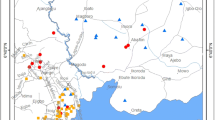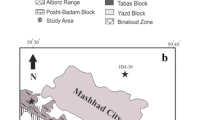Abstract
In this study an attempt was made to determine the source(s) and nature of Pb in environmental media of Ibadan, one of the largest cities in west Nigeria. Seventy-three samples comprising forty stream sediments, twenty-five soils and eight rocks samples were used for the study. Mineralogical compositions of the samples were determined by X-ray diffraction. The elemental constituents were determined using ICP-MS; while the Pb isotopes were determined using Sector-field ICP-MS. Sequential analysis of selected samples was carried out using a modified Tessier’s five-step method. The dominant minerals identified were quartz, kaolinite, k-feldspar, and plagioclase. The concentrations (mg/kg) of Pb in soils, sediments, and rocks ranged from 13.00–470.00; 89.00–3288.00 and 2.90–20.30, respectively. The 204Pb, 206Pb, 207Pb, 208Pb ranged from 1.72–47.41; 30.69–779.68; 27.00–664.46 and 65.67–1642.27 in the soils and sediments, respectively, while they ranged from 0.02–0.07; 0.56–2.33; 0.38–1.56 and 1.19–4.13 in the rocks. Further evaluation of Pb concentration in the soils and sediments revealed high to extreme Pb pollution status, while the calculated Pb isotopic ratios (IRs) in the soil and sediments varied from that of the underlying bedrocks. The IRS in soils and sediments were characterized by low (1.161–1.172 and 1.127–1.200, and 2.281–2.444 and 2.276–2.474) 206/207 Pb and 208/207 Pb, while those of the rocks were high (1.456–1.753 and 2.647–3.149), indicating additional anthropogenic sourcing of Pb in the soils and sediments. The analyzed Pb revealed fractions more partitioned in the reactive geochemical phases with the Pb partitioned in the exchangeable (0.11–0.23%), carbonate (9.00–43.58%), reducible (8.32–13.53%) and organic/sulfides (42.78–82.45%) phases. This implies that there may be enhanced mobility of Pb in the environmental samples and ultimately bio-adsorption into living tissues in the environment.








Similar content being viewed by others
References
Abimbola, A. F., Ajibade, M. O., & Kolawole, T. (2007). Assessment of heavy metals in soils around automobile mechanic workshops in Ibadan, southwestern Nigeria. Aquanterra. Journal of African Water Resources and Environment, 1(2), 14–22.
Abimbola, A. F., Kolawole, T., Ajibade, O. M., Odewande, A. A., & Asaah, V. A. (2006). Heavy metal in cattle market soil of Ibadan, southwestern Nigeria. Is there any environmental risk? Mineral Wealth, 138, 53–60.
Ahmed, G., Uddin, M. K., Khan, G. M., Rahman, M. S., & Chowdhury, D. A. (2009). Distribution of trace metal pollutants in surface water system connected to effluent disposal points of Dhaka Export Processing Zone, Bangladesh: A statistical approach. Journal of Natural Science Sustain Technology, 3, 293–304.
Apanpa-Qasim, A. F. I., Adeyi, A. A., Mudliar, S. N., Raghunathan, K., & Thawale, P. (2016). Examination of Lead and Cadmium in water-based Paints Marketed in Nigeria. Journal of Health and Pollution, 6(12), 43–49.
Asowata, I. T., & Olatunji, A. S. (2019). Tracking lead in environmental media in the City of Onitsha, Southeast Nigeria. Journal of Health and Pollution, 9(24), 191202. https://doi.org/10.5696/2156-9614-9.24.191202
Bird, G., Brewer, P. A., Macklin, M. G, Nikolova, M., Kotsev, T., Mollov, M., Swain, C. (2010). Pb Isotope evidence for contaminant-metal dispersal in an international river system: The lower Danube catchment, Eastern Europe. Journal of Applied Geochemistry. https://doi.org/10.1016/appliedgeochem.2010.04.012.
Bird, G. (2011). Provenancing anthropogenic Pb within the fluvial environment: Developments and challenges in the use of Pb isotopes. Environment International, 37, 802–819.
Brown, M. J., & Jaccobs, D. E. (2006). Correspondence: Sources of blood lead in children. Environmental Health Perspectives., 114(1), A18–A19.
Cai, K., Li, C., & Na, S. (2019). Spatial distribution, pollution source, and health risk assessment of heavy metals in atmospheric depositions: A case study from the sustainable city of Shijiazhuang, China.
Chen, J., Tan, M., Li, Y., Zhang, Y., Lu, W., Tong, Y., et al. (2005). A lead isotopic record of Shanghai atmospheric lead emissions during the period of phasing out of leaded gasoline. Atmospheric Environment, 39, 1245–1253.
Chiaradia, M., & Cupelin, T. (2000). Behavior of airborne lead and temporal variations of source effect in Geneva (Switzerland) comparison of anthropogenic versus natural River sediment cores: Implications for improved time stratigraphy and transport processes. Chemical Geology, 199, 53–70.
Erel, Y., Veron, A., & Halicz, L. (1997). Tracing the transport of anthropogenic lead in the atmosphere and in the soils using isotopic ratios. Geochimica Et Cosmochimica Acta, 61, 4495–4505.
Ettler, V., Mihalijevic, M., Sebek, O., Molek, M., Grygar, T., & Zeman, J. (2006). Geochemical and Pb isotopic evidence for sources and dispersal of metal contamination in stream sediments from the mining and smelting district of Pribram, Czech Republic. Environmental Pollution, 142, 409–417.
Federal Survey of Nigeria. (1964). Topographical sheet no. 264, published by Nigeria Geological Survey.
Hansmann, W., & Koppel, V. (2000). Lead isotopes as tracers of pollutant in soils. Chemical Geology, 171, 123–144.
Komarek, M., Ettler, V., Chrastny, V., & Mihaljevic, M. (2008). Lead isotopes in environmental studies: A review. Environ International, 34, 562–577.
Laidlaw, M. A. S., Mielke, H. W., Filippeli, G. M., Johnson, D. L., & Gonzalez, C. R. (2005). Seasonality and children’s blood lead levels: Developing a predictive model using climatic variables and blood lead data from Indianapolis, Indiana, Syracuse, New York and New Orleans, Louisiana (USA). Environmental Health Perspectives, 113(6), 793–800.
Li, X., Ramsey, M. H., Coles, B. J., & Thornton, I. (1995). Sequential extraction of soils for multi-element analysis by ICP-AES. Chemical Geology, 124, 109–123.
Mielke, H. W., Gozales, C., Powell, E., & Mielke, P. W. (2008). Urban soil-lead (Pb) footprint: retrospective comparison of public and private properties in New Orleans. Environmental Geochemistry and Health, 30, 231–242.
Monna, F., Lancelot, J., Croudace, I. W., Candy, A. B., & Lewis, J. T. (1997). Lead isotopic composition of airborne particulate material from France and the southern UK: Implication for lead pollution sources in urban areas. Environmental Science and Technology, 31, 2277–2286.
Mukai, H., Machida, T., Tanaka, A., Vera, Y. P., & Uematsu, M. (2005). Lead isotope ratios in the urban air of eastern and central Russia. Atmospheric Environment, 35, 2728–2733.
Muller, G. (1979). Schwermetalle in den sedimenten des Rhe-ins-Veranderungen seit 1971. Umschau, 79, 778–783.
National Population Commission of Nigeria. (2016). Nigerian’s population information. Official Bulletin. Retrieved March 30, 2018, from www.populationgov.ng.
Noerpel, M., Pribil, M., Rutherford, D., Law, P., Bradham, K., Nelson, C., Weber, R., Gunni, G., & Scheckel, K. (2020). Lead speciation, bioaccessibility and source attribution in Missouri’s Big River watershed. Applied Geochemistry, 123, 104757–104767. https://doi.org/10.1016/j.apgeochem.2020.104757
Noyak, M., Emmanuel, S., Vile, M., Erel, Y., Veron, A., Paces, T., et al. (2003). Origin of lead in eight European peat bogs determined from isotope ratios, strength and operation times of regional pollution sources. Environmental Science and Technology, 37, 437–445.
Nriagu, J. O. (1992). Toxic metal pollution in Africa. Science of the Total Environment, 181, 93–100.
Odewande, A. O., & Abimbola, A. F. (2008). Contamination indices and heavy metal concentrations in urban soil of Ibadan Metropolis Southwestern Nigeria. Environmental Geochemistry and Health., 30, 243–254.
Okunlola, O. A., Adeigbe, O. C., & Oluwatoke, O. O. (2009). Compositional and petrogenetic features of schistose rocks Ibadan area. Earth Science Research Journal, 13(2), 29–43.
Olatunji, A. S., & Afolabi, O.O. (2020). Assessment of Pb contamination of soils, sediments and road dusts of the City of Lagos, Nigeria. Journal of Environmental Geochemistry and Health, V. https://doi.org/10.1007/s10653-019-00330-6697
Olatunji, A. S., & Abimbola, A. F. (2010). Geochemical Evaluation of the Lagos Lagoon sediments and water. World Applied Science Journal, 9(2), 178–193.
Olatunji, A. S., Abimbola, A. F., & Afolabi, O. O. (2009). Geochemical assessment of industrial activities on the quality of sediments and soils within Lsdpc industrial estate, Odogunyan, Logos. Global Journal of Environmental Research, 3(3), 252–257.
Onianwa, P. C. (2001). Roadside topsoil concentrations of lead and other heavy metals in Ibadan, Nigeria. Soil Sediment Contamination, 10(6), 577–591.
Pobi, K. K., Nayek, S., Gope, M., Rai, A. K., & Saha, R. (2020). Sources evaluation, ecological and health risk assessment of potentially toxic metals (PTMs) in surface soils from an industrial area India. Environmental Geochemistry and Health, 42. https://doi.org/10.1007/s10653-020-00741-6697
Rahaman, M. A. (1988). Recent advances in the study of basement complex of Nigeria: In Precambrian Geology of Nigeria GSN Publication (pp. 11–43).
Rahman, M. A. (1976). Review of the basement geology of southwestern Nig. In C. A. Kogbe (Ed.), Geology of Nigeria (pp. 41–58). Elizabethan Pub. Co. Lagos.
Sturges, W. T., & Barrie, L. A. (1987). Lead 206/207 isotope ratios in the atmosphere of North America as tracers of US and Canadian emissions. Nature, 329, 144–146.
Veron, A., Flament, P., Bertho, M. L., Allemen, L., Flegal, R., & Hamelin, B. (1999). Isotopic evidence of pollutant lead sources in northwestern France. Atmospheric Environment, 33, 3377–3388.
Weather and Climate (Ibadan). (2019). Average Monthly weather conditions in Ibadan. Retrieved September 9, 2020, from www.weater-and-climate.com.
Zhu, L., Guo, L., Gao, Z., Yin, G., Lee, B., Wang, F., & Xu, J. (2010). Sources and distributions of Lead in the surface sediments from the South China Sea as derived from Pb isotopes. Marine Pollution Bulletin, 60, 2144–2153.
Acknowledgements
The authors gratefully thank the anonymous reviewers for their constructive comments on the manuscript.
Funding
No Fund was received for this research.
Author information
Authors and Affiliations
Corresponding author
Ethics declarations
Conflict of interest
The authors have not disclosed any competing interests.
Additional information
Publisher's Note
Springer Nature remains neutral with regard to jurisdictional claims in published maps and institutional affiliations.
Rights and permissions
About this article
Cite this article
Afolabi, O.O., Olatunji, A.S. Unraveling the source(s) and fate of Pb in urban soils and sediments of Ibadan metropolis using lead isotopes. Environ Geochem Health 45, 1525–1536 (2023). https://doi.org/10.1007/s10653-022-01274-0
Received:
Accepted:
Published:
Issue Date:
DOI: https://doi.org/10.1007/s10653-022-01274-0




